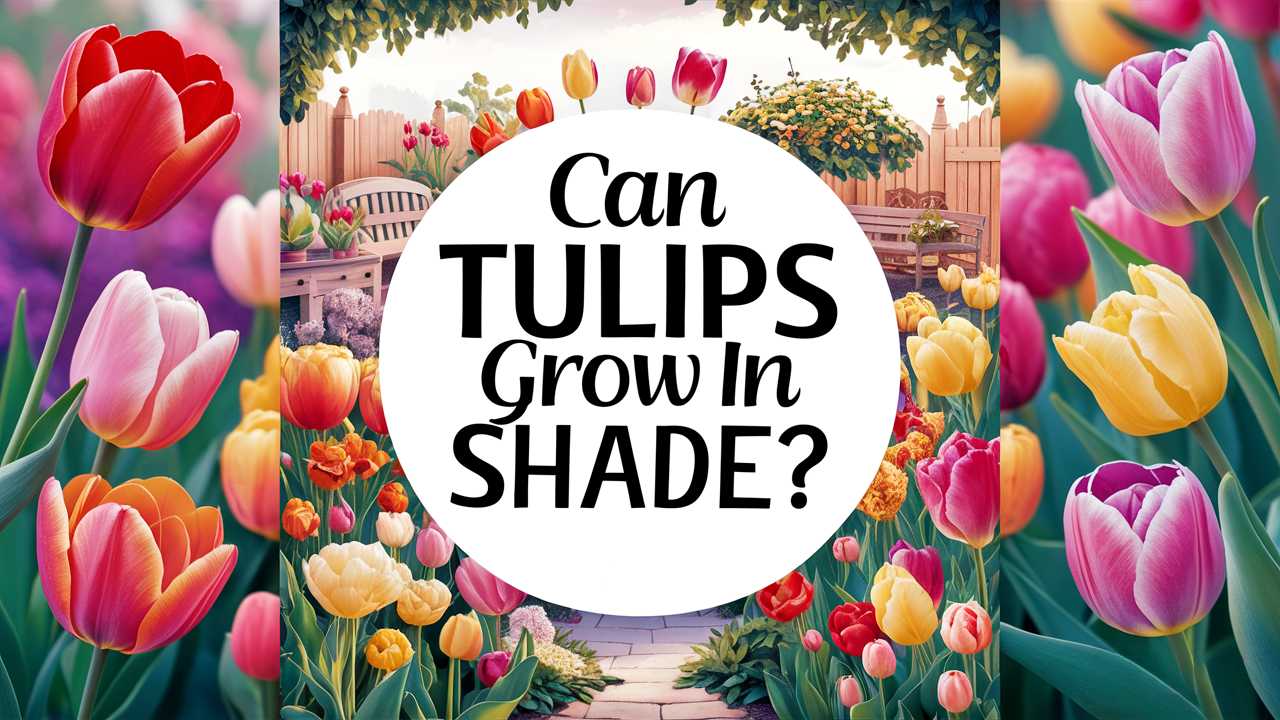If you’re wondering, “Can tulips grow in shade?”, this comprehensive guide will explore this question deeply, providing insights into tulip growth habits, light requirements, and tips for successfully incorporating these stunning flowers in shaded areas of your garden.
Understanding Tulip Growth Requirements

Before delving into the shade tolerance of tulips, it’s important to understand their overall growth requirements. Tulips are perennial plants belonging to the genus Tulipa and are native primarily to Central Asia and the Mediterranean region. Here are some key aspects of their growth that every gardener should know:
1. Light Needs
Tulips generally thrive in full sun conditions, which means they need at least 6 hours of direct sunlight each day to flourish. Sunlight is essential for the photosynthesis process, allowing these plants to produce energy for growth and blooming. A garden bed that receives ample sunlight typically yields the most vibrant blooms.
2. Soil Conditions
Tulips prefer well-draining soil that is rich in organic matter. Heavy or compacted soils can lead to bulb rot, so it’s vital to ensure that the soil drains well. The pH level should ideally be neutral to slightly acidic. Adding organic compost can improve soil structure and nutrient availability, effectively supporting healthy tulip growth.
3. Water Requirements
While tulips need adequate moisture, they are also susceptible to overwatering. It’s critical to keep the soil evenly moist, particularly during the growing season. However, once tulips finish blooming, it’s best to reduce watering as the bulbs enter dormancy.
4. Temperature Range
Tulips are well-suited to regions with cold winters and cool springs. They require a chilling period to break dormancy, making them apt for USDA hardiness zones 3-8. A temperature drop is necessary for the bulbs to produce flowers in the spring.
Tulips and Shade: What Research Shows

Given their preferences for sun, many gardeners may wonder if they can successfully grow tulips in shaded areas. Let’s examine how tulips interact with various degrees of shade:
1. Partial Shade Conditions
Although tulips love full sun, they can tolerate partial shade—typically defined as areas that receive 4-6 hours of sunlight each day or dappled sunlight throughout the day. In gardens that experience a mix of sun and shade, certain varieties of tulips may still thrive, albeit with some trade-offs in vigor and bloom quality.
When planting tulips in partial shade, consider the following:
Variety Selection: Some tulip varieties are better suited to shady conditions than others. Triumph tulips and Darwin Hybrid tulips tend to do particularly well in partial shade. These varieties may retain their strength and produce blooms despite reduced sunlight levels.
Timing and Blooming: Tulips can bloom a little later in shaded conditions as they may need more time to gather energy from sunlight. This delay can sometimes extend the flowering season into late spring.
2. Deep Shade Challenges
When it comes to deep shade—areas that receive less than 4 hours of sunlight per day—the challenges for tulip growth significantly increase. Deep shade is typically characterized by large trees or structures that block most light, making it difficult for tulips to thrive. Here’s what to consider:
Reduced Bloom Production: In these conditions, tulips may survive but struggle to produce flowers. Their energy reserves will not be sufficient to support blooming when deprived of adequate sunlight.
Foliage Over Flowering: In deep shade, you may see vigorous green foliage, which is an indicator that the tulips are alive and growing, but flowering will likely be minimal or non-existent.
Competing Plants: Areas with significant shade may also host more aggressive plants. The competition for light and nutrients can further inhibit tulip development.
Strategies for Growing Tulips in Shaded Areas

If you’re determined to plant tulips in shaded areas, there are strategies you can employ to increase your chances of success. Here are some practical tips for growing tulips in less-than-ideal light conditions:
1. Site Selection
Even within a shaded garden, conditions can vary. Select the sunniest possible location, preferably where the sun peeks through during certain times of the day. Areas near buildings or garden structures that provide some light exposure can accommodate tulips better than deeply shaded sections.
2. Companion Planting
Consider planting tulips among companion plants that thrive in similar conditions. Plants such as hostas, ferns, or shaded perennials can provide a compatible environment while adding visual appeal. Companion planting can also help manage soil quality and moisture levels.
3. Amending Soil
Improving soil health can make a considerable difference. Adding organic matter ensures that the bulbs receive adequate nutrients. Compost also enhances drainage, which is crucial for healthy bulb development.
4. Mulching
Using mulch can help retain soil moisture while also keeping the soil temperature stable. Opt for organic mulch, as it enriches the soil as it breaks down. However, be careful not to cover the bulbs too deeply; a layer of 2-3 inches is usually sufficient.
5. Strategic Pruning
If trees or shrubs are causing excessive shade, strategic pruning can help increase light exposure to tulips. By selectively removing lower branches or thinning out dense foliage, you can allow more sunlight to penetrate the area where the tulips are planted.
6. Timing Planting and Watering
Consider the timing of when you plant your tulips. Planting them in early fall allows them to establish roots before the ground freezes, which can be significant in shady areas. Additionally, monitor soil moisture closely, particularly in shaded areas that may retain water longer.
Tulip Varieties to Consider for Shaded Areas

When selecting tulips for shady conditions, some varieties are inherently more adaptable than others. Here are some types of tulips that have shown a bit more resilience in shade:
1. Triumph Tulips
These tulips are known for their short stature and sturdy stems. Triumph tulips flower early and come in a range of colors. They can withstand some shade while still flowering reasonably well.
2. Darwin Hybrid Tulips
Recognized for their robust composition, Darwin Hybrid tulips are one of the most durable tulip varieties. They produce large blooms and are ideal for naturalizing, making them a good choice even in slightly shaded conditions.
3. Botanical Tulips
Less common than their hybrid cousins, botanical tulips (like Tulipa sylvestris) are often more tolerant of irregular light. They are smaller and can naturalize well, making them ideal for gardens that may not provide full sun.
4. Greigii Tulips
Greigii tulips are unique for their lovely foliage, which is often mottled or striped. These tulips can handle more shade than many others and can be charming in a woodland garden setup.
Tips for Maintaining Tulips in Shade

Caring for tulips in shaded environments requires some diligence and understanding of their needs. Here are some maintenance tips to keep your tulips healthy and thriving:
1. Regular Monitoring
Keep an eye on your tulips as they grow. Regularly check for signs of stress or disease, paying particular attention to any fungal infections that may arise due to excess moisture in shaded areas.
2. Fertilization
Fertilizing your tulips in spring with a balanced fertilizer can give them the extra nutrients they need to bloom. However, use caution not to over-fertilize, particularly in shaded soils that may already be enriched.
3. After Bloom Care
Once tulips have bloomed, allow the foliage to die back naturally. This process helps the bulbs store energy for the next growing season. If you cut green foliage too soon, the bulbs may not have enough stored energy to function well the following year.
4. Pest and Disease Management
In shaded environments, pests and diseases like bulb rot can become a concern. Regularly inspect for any signs of trouble, and address these issues promptly to safeguard your plants.
Conclusion: Finding Beauty in Shade
While tulips do have specific light requirements that generally favor sunny environments, with thoughtful planning and the right strategies, they can still find a home in shaded areas. Understanding the needs of tulips and recognizing their limitations is key when adapting your gardening practices. By selecting the right varieties, improving soil conditions, and monitoring care, gardeners can still enjoy the striking beauty of tulips even amid trees and buildings.





